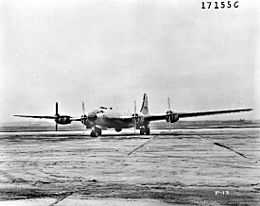1948 Lake Mead Boeing B-29 crash facts for kids

An F-13 variant of the Boeing B-29 Superfortress, similar to the accident aircraft
|
|
| Accident summary | |
|---|---|
| Date | 21 July 1948 |
| Summary | Controlled flight into terrain (CFIT) due to pilot error |
| Place | Lake Mead, Nevada, US |
| Passengers | 0 |
| Crew | 5 |
| Injuries (non-fatal) | 0 |
| Fatalities | 0 |
| Survivors | 5 |
| Aircraft type | Boeing F-13 Superfortress |
| Airline/user | United States Air Force |
| Registration | 45-21847 |
| Flying to | Armitage Field (now NAWS China Lake), California |
The 1948 Lake Mead Boeing B-29 crash happened on July 21, 1948. A large airplane, a Boeing B-29 Superfortress, was flying over Lake Mead in Nevada, US. This plane was special. It had been changed into an F-13 model for looking at the weather and air. Sadly, it crashed into the lake's water.
What Happened?
The B-29 plane, known as "Lake Mead's B-29," started flying on September 13, 1945. Its special number was 45-21847. In 1947, its weapons were taken off. It was then called an F-13 plane. This meant it was used for looking at things from above.
The plane joined a project to study the upper atmosphere. This project aimed to create a guidance system for missiles. This system would use the sun to find its way. It was called "Sun Tracker." To test it, they needed a plane that could fly very high. Then it needed to quickly fly very low. The B-29 was a good choice. It was the first plane made in large numbers with a special cabin. This cabin kept the air pressure normal for the crew. Also, after World War II, many B-29 planes were available.
On July 21, 1948, Captain Robert M. Madison and his crew finished a high flight. They were flying at about 30,000 feet (9,100 m) east of Lake Mead. Then they started to fly lower. They leveled out just over 300 feet (91 m) above the lake's surface. The crew said the lake looked like a mirror. The sun was shining very brightly off the water. These conditions make it very hard to tell how high you are above the surface.
The plane slowly flew lower than 100 ft (30 m). Then it hit the water at 250 mph (400 km/h). It started skipping across the surface. Three of the plane's four engines broke off. The fourth engine caught fire. The plane managed to go up about 250 ft (76 m). But then it came back down onto the water. It landed with its nose up and slowly slid to a stop. The five crew members got out into two life rafts. They watched the plane sink into the lake.
The crew was saved from the lake six hours later. They were told not to talk about the flight. They could not share details about their mission or why the plane was lost. Since the mission was a secret, these details were not shared until fifty years later.
Finding the Wreck
|
B-29 Serial No. 45-21847
(Heavy Bomber) |
|
 |
|
| Nearest city | Overton, Nevada |
|---|---|
| NRHP reference No. | 11000212 |
| Added to NRHP | 20 April 2011 |
In 2001, a private dive team found the B-29 wreck. They used a special tool called sidescan sonar. This tool uses sound waves to create images of the lake bottom. The plane was found in the Overton Arm of Lake Mead. Because the plane was inside a National Recreation Area, the National Park Service became responsible for the site.
The bomber itself is now on the National Register of Historic Places. This means it is an important historical site. In July 2007, the National Park Service started a six-month test. They allowed private companies to lead special dives to the B-29 site. One company was Scuba Training and Technology Inc. / Tech Diving Limited.
The National Park Service was happy with how well the site was kept safe. But in 2008, they closed the B-29 site for diving. This was to help protect it even more. In December 2014, the National Park Service asked for new companies to lead dives. Scuba Training and Technology Inc. / Tech Diving Limited was chosen again. Diving started again in April 2015.
In 2017, the National Park Service closed the B-29 site for diving once more. This was for more protection efforts. On May 30, 2019, the Park Service asked the public for their thoughts. They wanted to know if they should allow guided trips to the site again.

